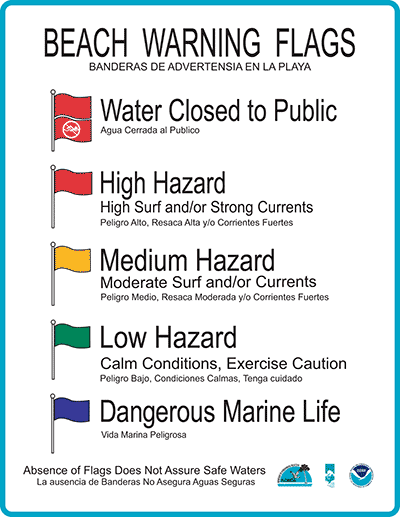
How many times have you been at the beach, seen a colored flag flying, and wondered for a split second what it meant? Then carried on with your beach frolicking, not giving it a second thought? Please, if you don’t already know, learn what these flags mean, and heed their warnings. They really do help keep you safe.
On Sunday afternoon, in Fort Morgan, Alabama, a teenage boy was swept away by a rip current…the search for him continues as of Monday morning, March 26th. A red flag was flying – that afternoon it was changed to a double red flag.
So what exactly does this mean? Green, yellow, red, double red flag? And purple? It’s easy to remember if you think of it as a stop light. Green flags mean “all clear”, although you must still use caution. It’s the ocean, after all, and there are still unseen hazards, but the water is calmer and the green flag shows that it’s safe to swim. Never go out alone, and always keep an eagle’s eye out on your kiddos. Yellow flags mean that the water is rough, but not life threatening. Conditions are right for rip currents and undertows, so be extra careful. Red flags: I don’t even let my kids in the water past their knees with one red flag. One red flag indicates dangerous waters – high surf and/or dangerous currents. It doesn’t take a second to get caught in a rip current and pulled out to sea, and they are so unpredictable you can’t see them.
Two red flags means absolutely no swimming, it’s just too dangerous, and along the Gulf Coast beaches it is actually illegal. And lastly the purple flag, or dark blue as it appears to some people, means dangerous marine life is in the area, such as sharks, jellyfish or other dangerous marine life. Swimming may be permitted with the purple flag is posted, but I wouldn’t go in the water with a purple flag flying, either.
Our heart aches for this young man and his family. Please respect the potential dangers of the beautiful sea, and keep an eye out for these flags and know their meanings.



